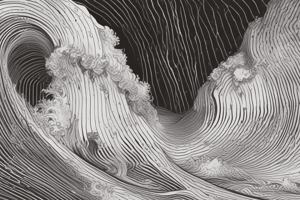Podcast
Questions and Answers
Which of the following statements about sound waves is true?
Which of the following statements about sound waves is true?
- Sound waves can travel through a vacuum.
- Sound waves move faster in air than in water.
- Sound waves are mechanical waves that require a medium. (correct)
- Sound waves are longitudinal waves that do not exhibit interference.
What is the primary factor that determines the frequency of a sound wave?
What is the primary factor that determines the frequency of a sound wave?
- The speed of sound in that medium. (correct)
- The length of the wave.
- The medium through which the wave travels.
- The amplitude of the wave.
Which of the following best defines pitch?
Which of the following best defines pitch?
- The loudness of a sound.
- The perceived frequency of a sound. (correct)
- The quality or timbre of a sound.
- The duration of a sound.
What is the result of constructive interference of sound waves?
What is the result of constructive interference of sound waves?
Which of the following describes the Doppler effect?
Which of the following describes the Doppler effect?
Flashcards
Biomedical Physics Course
Biomedical Physics Course
A course focusing on applying physics principles to medicine and imaging.
Sound and Hearing
Sound and Hearing
Study of sound waves and how the human ear processes them.
File no. 6
File no. 6
A specific file relating to the content.
Chapter 5
Chapter 5
Signup and view all the flashcards
Study Notes
Biomedical Physics Course (7108101)
- Course offered by the Department of Biophysics and Medical Imaging, Faculty of Medicine and Health Science, An-Najah National University.
Chapter 5: Sound and Hearing
- Sound is a vibration that propagates through a transmission medium (e.g., air).
- Hearing allows identification and recognition of objects based on sound.
- Sound is derived from vibrating objects producing pressure variations in a transmitting medium.
- Sound propagates outward as a pressure wave.
- The eardrum vibrates, initiating the hearing process.
Chapter Outline
- Sec. 5.1: Sound waves in Media
- Sec. 5.2: Ultrasound Sonography
- Sec. 5.3: The Ear anatomy and Hearing Process
What is Sound?
- Sound is a wave that transfers energy through a medium (air, water, earth).
- Sound is typically caused by vibrations (from colliding objects or vocal chords).
- "Sound waves" specifically refers to waves detectable by humans.
- Sounds outside this range are called infrasonic (too low) or ultrasonic (too high).
- Sounds within the human hearing range are called sonic.
Sound Generation
- To create sound, something must move with sufficient intensity to create an air pressure wave.
- Dropping a rock on a hard surface creates a sound with many frequencies that quickly dampens.
- Striking a metal rod produces distinct frequencies determined by its length, mass, and radius.
Human Sound Generation and Resonance
- Vocal chords and nasopharyngeal cavity alter sound pitch.
- Ears are sensitive to certain frequencies due to resonance in the ear canal.
- Resonance is when a vibrating system is driven by an external force, causing oscillations at specific frequencies.
Sound Wave
- Sound waves are a moving disturbance of molecules in a transmitting medium (e.g., air).
- Compressions are areas where molecules are closer together.
- Rarefactions are areas where molecules are more spread out.
Sound Properties
- Frequency is the number of cycles per second (Hz).
- Amplitude is the wave's height and relates to intensity.
- Speed of sound varies depending on the medium and temperature.
Pitch
- Pitch describes how high or low a sound is.
- High pitch sounds are associated with faster vibrations.
- Low pitch sounds have slower vibrations.
- Pitch is measured in hertz (Hz).
Amplitude and Intensity
- Amplitude measures how dense the medium molecules are.
- Intensity is a measure of energy transported through a unit area per second (Watts per m²).
- High amplitude = high intensity = louder sound.
Loudness or Volume
- Loudness describes how loud or quiet a sound is.
- Loud sounds have larger amplitude/height.
- Volume is measured in decibels (dB).
Intensity, Loudness, and the Decibel Scale
- Decibels (dB) quantify the intensity ratio of sounds on a logarithmic scale (powers of 10).
- The formula for intensity ratio in dB = 10 × log(intensity₂ / intensity₁).
- A reference sound intensity is typically used when calculating sound in dB.
Example
- Intensity of a jet plane (at 30m) = 100 W/m².
- Example decibel levels (for various sounds).
Speed
- Sound waves need a medium to travel (solid, liquid, or gas).
- Sound speed varies with the medium and environmental conditions (temperature).
- In dry air at 20°C, sound travels at approximately 343 m/s.
- Sound speed increases by ~ 0.6 m/s for each 1°C rise in temperature.
- The speed of sound depends on the elasticity (or resistance to deformation) and density of the material (or medium).
- Common sound propagation speeds in different media.
Sound Wave Interaction with Objects
- When sound waves encounter a boundary between different media, they can be reflected, transmitted, or absorbed.
- These behaviors depend on acoustic impedance.
- Acoustic impedance describes the resistance of a medium to the propagation of sound waves.
- Higher impedance leads to more reflection.
Reflected and Absorbed Sound
- Reflected sound proportion is calculated using sound impedances.
- Proportion transmitted is calculated as (1 - proportion reflected).
- The absorbed sound energy converts to different forms, such as heat.
Sec 5.2: Ultrasound Sonography
- Ultrasound is used for medical imaging techniques.
- The technique uses ultrasound waves to produce images of structures inside the body.
Ultrasound Imaging
- Ultrasound imaging uses reflected sound wave patterns to create detailed maps of internal structures.
- Computers interpret received pulses and create images of tissues and organs.
Ultrasound Image
- Reflected sound creates the imagery; more reflection results in a brighter (whiter) image.
- Fewer reflections result in a darker (blacker) image.
- A neutral reflection is an "isoechoic" image.
Sonar
- Sonar uses reflection principles similar to ultrasound for detecting objects in water.
- Bats use echolocation (a form of sonar) to "see" using emitted and reflected sounds.
Studying That Suits You
Use AI to generate personalized quizzes and flashcards to suit your learning preferences.




